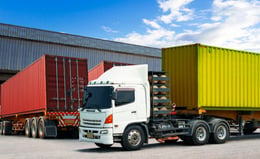5 Myths About Transport Logistics
Nick Ostdick - October 03, 2017

For so many companies in today’s digital manufacturing landscape, so much of transport logistics is still shrouded in mystery. Because a majority of manufacturing companies place a greater emphasis on earlier stages of the production cycle (planning, procurement, inventory management, and job allocation), little attention is often paid to successfully administering a transport management system or structure that effectively helps companies reduce transport costs and optimize transit processes.
This lack of visibility, as with almost every other aspect of global supply chain management, allows for misinformation or inaccurate understandings of just how and why an integrated transport logistics strategy is a critical value proposition for today’s manufacturing companies. Moving finished products from the production floor to the customer’s front door on-schedule and in good order is part and parcel of what effective production programs are all about, and transport logistics are a key driver in helping manufacturing companies achieve this ever-important goal.
To help clear away the fog around transport logistics and reduce the amount of misinformation about this important element of global SCM, let’s examine 5 myths about transport logistics and the actual facts behind these different aspects of transport logistics.
Myth #1: Transport logistics don’t really reduce overall freight costs.
Wrong. Because transportation is not a fixed cost, coordinating a transport logistics platform where planners and managers have increased visibility and transparency into the constantly shifting variables is key to reducing overall transportation costs and optimizing the output of resources to ensure the best return in both efficiency and revenue. History is instructive, and manufacturing companies who can gather, sort, analyze, and review previous transportation data are better equipped to explore areas where costs can be reduced and optimized for more effective future transport planning. A transport logistics solution gives planners and managers the power to uncover areas of waste in their transportation strategy (container levels, fuel consumption, inaccurate routing processes, ineffective distribution and warehousing networks, and long lead times between warehousing and delivery) to deploy more lean methods of transportation and avoid bottlenecks or breakdowns in the transit stage of their value chain.
Myth #2: It’s difficult to integrate transport logistics into an Industry 4.0 platform.
Actually, transport logistics is tailor-made for an integrated Industry 4.0 strategy. Because Industry 4.0 relies heavily on intelligent solutions communicating data, reporting, and notifications in real-time, Industry 4.0 is perhaps a perfect fit for transport logistics in terms of identifying changing variables in transportation constraints and addressing these variables before they result in breakdowns or bottlenecks. In addition, because transport logistics is often reliant on a large network of partners, stages, or processes, integrating Industry 4.0 into a transport strategy is a seamless way of connecting these disparate points into a cohesive system or architecture whereby all the important players can communicate, collaborate, and respond to transport logistics events with little or no lead time. No longer are manufacturing companies operating their transport logistics strategy on outdated data or irrelevant communication threads. Today, Industry 4.0 allows these functions to take place in the moment between as many players as necessary.
Myth #3: Transport logistics is simply too rigid to align with shifts in operational practices.
No. In fact, transport logistics provides manufacturing companies enhanced agility and flexibility. Imagine a certain production program is scheduled to produce X amounts of units that need to be transported to a certain distribution facility by a certain date. However, unforeseen changes to said production program means a significant reduction in the number of units, which directly impacts transport capacity. Where before a manufacturing company had budgeted enough space to move X amount of units, this reduction either means a longer lead time to when a full truck/container can be shipped, or an inefficient use of capacity whereby a half or less than half truck or container is utilized. However, a transport logistics strategy and solution gives planners and managers the power to adapt to these operational shifts by identifying the best routes, transport modes, and delivery windows to avoid incurring losses in resources and time in addressing these changing variables. In addition, a transport logistics solution allows manufacturing companies to engage in simulations and what-if scenarios to plan accordingly for such events.
Myth #4: Transport logistics has very little to do with increasing customer relations and satisfaction.
The value of a transport logistics solution in enhancing customer satisfaction and service cannot be overstated. While the value proposition internally for manufacturing companies should now be quite apparent, the value externally or in a customer-facing avenue should be easily visible from the start. A company’s ability to provide the right product at the right time in the right place is paramount in driving a positive customer relations platform and increasing a company’s client base and footprint. Because a transport logistics solution provides planners and managers the power to ensure the right products arrive in the right condition at the right moment, customers will not only be more apt to work with a given manufacturing company in the future, but said manufacturing company will also create more stable and productive business relationships with partners in their supply networks.
Myth #5: Transport logistics resides outside the realm of the digitization of the supply chain.
Not true. As we’ve just discussed, transport logistics is an integral part of Industry 4.0, which by itself is a critical driver of global supply chain digitization. Because a transport logistics platform works to remove cross-organizational silos particularly at the tailend of the production cycle, the end result is a more visible, transparent production scheme. This is also the end goal of digitizing the supply chain: a greater potential for E2E visibility in variant-rich industry which necessitates the capacity for insight into internal and external processes.
If you want to learn more get your Guide to Industry 4.0:
LATEST POSTS
- Understand Circular Economy in The Manufacturing Industry
- How Can Industry 4.0 IT Integration Be Achieved Smoothly?
- The Significance of Order Sequencing in Discrete Manufacturing
- How to improve your Supply Chain Management: The Power of Control Towers
- Optimizing Human Resource Scheduling in Manufacturing: A Technological Approach



